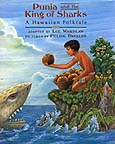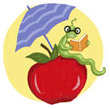
Teacher’s Guide for
Punia and the King of Sharks
A Hawaiian Folktale
Retold and Adapted by Lee Wardlaw
Pictures by Felipe Davalos(This guide may be reproduced without permission for classroom use.)
About the Book:
Ever since Punia’s father was eaten by the King of Sharks and his followers for daring to go into their lobster cave, there’s been no one to fish for Punia and his mother – and no more tender lobsters to eat. Day after day Punia’s mother prepares yams and poi for dinner, often longing for a savory lobster while Punia’s stomach rumbles in agreement. But one day, as he gazes at the sleeping sharks in the clear, blue sea, Punia comes up with a devilish plan to steal the lobsters from the cave, and the sharks are in for some unexpected surprises! In this Hawaiian folktale about a fisherman’s enterprising son, Lee Wardlaw takes the reader on a rollicking adventure as Punia cleverly outwits the sharks and becomes the hero of the island village. Felipe Davalos’s illustrations capture the humor of the young boy who courts danger and triumphs over it.
About the Author:
Lee Wardlaw is the author of more than 20 award-winning books for young readers. She has traveled extensively throughout Hawaii, where she enjoys bodysurfing, hiking and eating lobster. She lives in Santa Barbara, California, with her husband, son, and two cats (Mai Tai and Papaya).
Pre-reading:
Just by looking at the cover art, what can you guess the story will be about? Where will the story take place - - and when? What do you think the boy is doing? What is a folktale?
Discussion Guide:
- Read the glossary and pronunciation guide. Have you heard of any of these words before? What do you already know about them? How will they help you understand the story better?
- Who guards the lobster cave? What do they do with anyone who tries to trespass? What does it mean to “devour” something?
- Why must Punia and his mother eat only Poi and yams? What does Punia plan?
- How does Punia trick the sharks the first time? Why does he blame it on the shark with the flat nose?
- Would you be willing to go into the water with all those sharks? Should Punia’s mother forbid him to reenter the water? Would yours?
- Explain how Punia uses poi to trick the sharks the next day. How does Punia get rid of yet another shark?
- How does Punia trick the sharks into thinking he is the Mano, God of Sharks? Why does the king banish all the other sharks from the cave?
- Describe how Punia defeats the King of Sharks once and for all. What trick does he use? How does it nearly backfire on him?
- What vow does the shark finally make to Punia? Why? Does he keep his promise? Are you surprised when he does? Why or why not?
- What do the villagers do to honor Punia? Why can they now have lobster whenever they want? Would you like to have a lu’au in your honor?
Activities:
Just for fun:
Have a Hawaiian lu’au – research the foods you should make, create decorations with palm trees and pineapples, and design your own tapa clothing. Wear beach clothes like Hawaiian shirts and flip flops, create paper leis, do the limbo, choreograph a hula, eat on beach towels and listen to great Hawaiian music!
Language Arts:
- Setting is the term people use when they talk about where a story takes place, where the events in the story happen. Discuss what the setting is in Punia and the King of the Sharks. Next, draw pictures of what readers might see if the story took place in these other settings: in a desert, in Alaska, on a farm, or at a school.
- As a class, write your own adventure where you outsmart another animal. How would you outsmart a bear, snake or lion? What would you use to trick them like Punia did?
- For older students, include a glossary of terms for people who may not be familiar with your world (like soccer terms, horseback riding, snorkeling, etc).
Reading:
- Brainstorm a list of words that begin with the “sh” sound in shark. Using newspapers and old magazines find five other words that begin with “sh.” Can you think of other animals that begin with a blend? List those too!
- Read a folktale from another culture and compare it to Punia’s story. Create a Venn diagram to show what things they have in common and how they are different. For extra credit read a third story and add that circle to your diagram as well.
Math:
Plan a vacation to Hawaii. Create an itinerary and research how much the trip would cost. Create an itemized expense list that includes flight, lodging, rental car, and a budget for entertainment and food. Use all of these details to create a travel pamphlet.
History/ Geography:
- For younger students, find the Hawaiian Islands on a globe and on a map. As a class, measure the distance Hawaii is to mainland America.
- Research one of the topics from the book and give a short five minute presentation to your class about what you learned:
| Volcanoes of Hawaii |
Native People of Hawaii |
| Traditional foods |
Traditional clothing |
| Hawaiian language |
Climate |
| Geology |
Volcanoes |
| Tsunamis |
Flora and Fauna of Hawaii |
| Crops and exports |
Tourism |
| Native animals and plants |
Sharks |
| Surfing |
Games |
| The Hula |
Gods and Goddesses |
Art:
Take a large piece of cardboard and cut it into a surfboard shape. Then, design your own logo or style and paint it. Look at Hawaiian quilts and textiles for inspiration!
Music:
Science:
Visit these great websites then make a list of the ten most interesting facts you learned about sharks. Illustrate on a poster and share with your class!
http://www.mbayaq.org/efc/sharks.asp
http://www.pbs.org/wgbh/nova/sharks/
http://www.seaworld.org/animal-info/info-books/sharks-&-rays/index.htm
http://www.jason.org/expeditions/jason7/index.html
This guide was created by Tracie Vaughn Zimmer, a reading specialist and author of Reaching for Sun. Visit her website to find many other guides to children’s literature.
|







